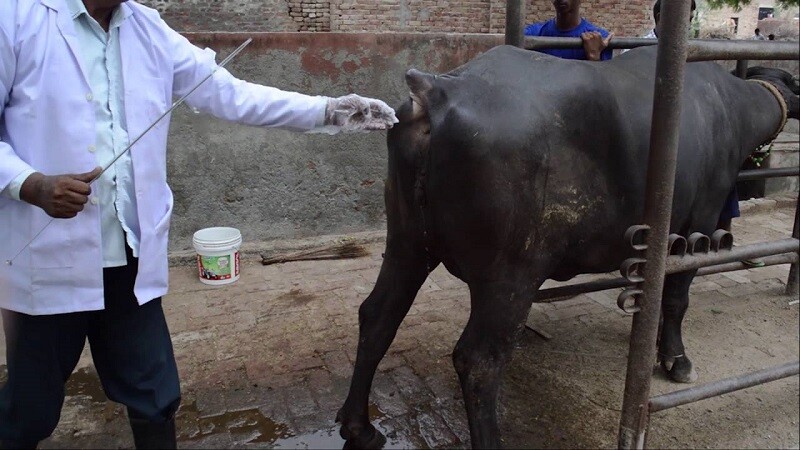

Artificial Insemination (AI) is one of the most important techniques ever devised for the genetic improvement of farm animals. Its greatest advantage is that there is maximum use of superior bulls which does not happen with natural service. The danger of spreading infectious genital diseases is also reduced since exposure of sires to such ailments is curbed. Through AI, one can also detect early infertile bulls, use old or disabled bulls and it eliminates the danger of handling unruly bulls.
The demerits of the procedure include the fact it requires special facilities and skills that are obtained through training. Only qualified AI service providers are allowed to practice.
Causes of AI failure in cows: They are both human and animal. The farmer and the inseminator unwittingly contribute to most of these failures through acts of omission and commission.
The farmer
Failing to detect heat is the most frequent cause of reproductive failure in herds bred artificially. As a farmer, knowledge of the heat cycle dynamics and keeping of accurate breeding records are essential in minimising AI failure. To enhance chances of conception, the farmer needs to avoid inaccurate reporting of heat especially the time when the cow started showing signs of ‘standing heat’.
This is the period when a cow stands to be mounted by others or moves forward slightly as it is being mounted. This is the most accurate sign of oestrus, marking the most sexually intensive period of the oestrous cycle and lasts for 15 to 18 hours.
Cows that move away quickly when a mount is attempted are not in true oestrus. For the standing behaviour to be expressed, the cow obviously must be allowed to interact.
Ovulation occurs 25 to 32 hours after the onset of standing heat but fertilisation will only take place at the uterine horns (fallopian tube or oviduct) before the egg reaches the uterus.
The egg travels very rapidly from the ovulation site to the fertilisation site in the oviduct but the sperms have to be in the female reproductive tract for approximately six hours before they are capable of fertilising the egg.
Apart from the real risk of fertilisation failure, breeding either too early or too late allows an aged sperm or an aged egg to interact at the site of fertilisation and will result in poor conception due to embryonic deaths.
The best time to inseminate is during the second half of the standing heat period and, therefore, most inseminators use the ‘AM-PM rule’ to ensure conception. With this rule, if standing heat is first reported in the morning hours, then insemination is done in the afternoon but if heat is reported in the evening, then insemination is done the following morning. It is, therefore, imperative that the farmer accurately reports the time of the first signs of standing heat. In addition, keeping breeding records such as the dates of last calving and last heat helps a farmer to forecast the probable dates of the next heat signs.
The Inseminator
An incompetent inseminator contributes to the failure through improper semen handling and incorrect insemination techniques or procedure. Spermatozoa contained in the semen can be destroyed through improper handling, exposure to sunlight or contact with either water or blood.
Use of dirty equipment, failure to dry semen straws in warm water after thawing and injury to reproductive tract during insemination will hamper spermatozoa survival. Frozen semen needs to be thawed well before insemination. Thawing practices such as rolling of straws between hands or placing under the armpit are wrong. For the fertilisation and conception to occur, semen has to be deposited precisely within the uterus at the right time which needs a properly qualified AI technician.
Animal factors
Loss of weight before or after insemination may negatively affect the critical stages of early embryonic development and maternal recognition of pregnancy. Mounting activity and other sexual behaviour decrease in cows that have lost more weight since calving. Poor nutrition, on the other hand, causes your cow to fail to show clear signs of heat. This makes it difficult to know the right time for insemination.
Feeding your cows with a balanced ration and maintaining the same plane of nutrition before and after breeding is crucial. Keep your cattle free of internal parasites and provide adequate amounts of feeds containing the necessary nutrients, especially energy, protein, Vitamin A, calcium, phosphorus and selenium.
This will improve herd fertility and longevity, ensuring that after insemination, the resulting embryo will fully attach to the uterus.
Another factor that hinders success of AI is an abnormal, injured or infected reproductive tract. Malformations of the cervix may make it hard for the inseminator to deposit semen. Culling the affected cow may be a better option in such a case since it difficult to provide a lasting remedy.
Infections of the reproductive tract can cause either silent heat or abortion. But the infections can be treated by consulting a vet or qualified animal health practitioner.
Hormonal imbalances, especially those involving the balance of follicle stimulating hormone and luteinising hormone due to reasons such as ovarian dysfunction also cause embryonic death.
Use of semen with less than optimum concentration and quantity reduces the chances of successful fertilisation. It is, therefore, crucial to insist on semen from reputable breeding stations.
 Contact Jaguza Support
Contact Jaguza Support